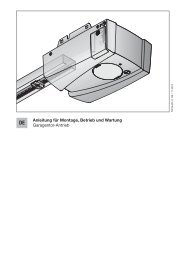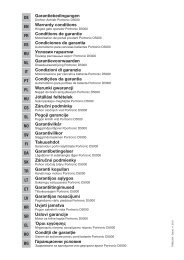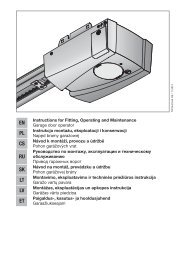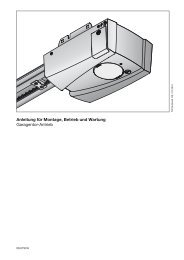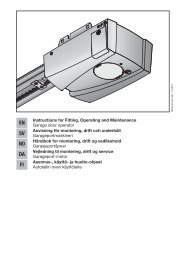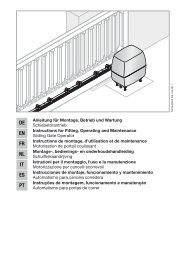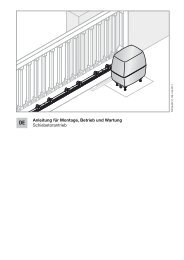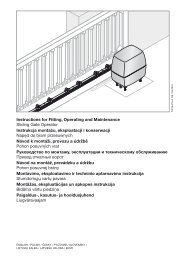Template BA B168xH238 - EcoStar
Template BA B168xH238 - EcoStar
Template BA B168xH238 - EcoStar
You also want an ePaper? Increase the reach of your titles
YUMPU automatically turns print PDFs into web optimized ePapers that Google loves.
ENGLISH<br />
– A larger dimension B reduces the speed at the gate<br />
closing edge in the OPEN direction<br />
– Always select a large dimension B if you want a large<br />
gate opening angle. The operator must be<br />
programmed for slow speed (see section 4.6.2).<br />
• The max. gate opening angle decreases with a larger<br />
dimension A.<br />
– For a large gate opening angle and/or small A<br />
dimension, the operator must be programmed for<br />
slow speed (see section 4.6.2).<br />
• To reduce the overall forces on the spindle, dimension A<br />
and the distance between the pivot point of the gate and<br />
the spindle attachment to the gate must be as large as<br />
possible.<br />
Notes:<br />
• Selecting an unnecessarily large opening angle will impair<br />
gate travel.<br />
• The values indicated in the table in Figure 1 are only<br />
guidelines.<br />
3.2.4 Attaching the fittings<br />
The fittings provided are galvanized and prepared for aftertreatment.<br />
Stone or concrete posts<br />
Observe the recommendations for plug hole edge distances.<br />
For the plugs included in the delivery, the minimum distance<br />
is one plug length.<br />
Turn the plugs so that the direction the plug spreads is<br />
parallel to the edge.<br />
Adhesive bond anchors, which allow a grub screw to be glued<br />
into the brickwork free of tension, offer an even better hold.<br />
For masonry posts, the post bracket should be fitted or<br />
welded to a large steel plate that is screwed onto and covers<br />
multiple bricks.<br />
An angle plate that goes around the edge of the post is also<br />
good for fitting.<br />
Steel posts<br />
Check whether the available support is stable enough. If this<br />
is not the case, it must be reinforced.<br />
Using rivet nuts may also be expedient.<br />
The fittings can also be welded on directly.<br />
Wooden posts<br />
The gate hardware must be tightened using through-holes.<br />
Use large steel washers or, even better, a steel plate on the<br />
rear of the post to ensure that it cannot come loose.<br />
3.2.5<br />
Fitting the operator<br />
ATTENTION<br />
Dirt<br />
Drilling dust and chippings from drilling work can lead to<br />
malfunctions.<br />
▶ Cover the operator during drilling work.<br />
▶<br />
▶<br />
Pay attention that fitting is horizontal, stable and secure<br />
at both the post and gate leaf.<br />
If necessary, use other suitable connectors. Unsuitable<br />
connectors may not hold up to the forces resulting during<br />
opening and closing.<br />
To fit the hinged gate operator:<br />
1. Fit the post fitting in accordance with the determined<br />
dimensions, grease the appropriate bolt and fix the<br />
operator (see Figure 2.1).<br />
2. Unscrew the linking bar out to the maximum marking.<br />
3. To create a reserve, screw the linking bar back in by ½ a<br />
turn (see Figure 2.2).<br />
4. Grease the appropriate bolt, fit the linking bar fitting and<br />
temporarily attach to the gate with a screw clamp (see<br />
Figure 2.2).<br />
5. Check the final dimensions by manually moving the gate<br />
into the end-of-travel positions while the operator is<br />
disengaged (see Figure 2.3).<br />
6. Mark the drill holes, remove the screw clamp, drill both<br />
holes and fix the linking bar fitting (see Figure 2.4).<br />
3.3 Fitting the operator control<br />
WARNING<br />
Danger of injury due to unwanted<br />
gate travel<br />
Incorrect assembly or handling of the<br />
operator may trigger unwanted gate<br />
travel that may result in persons or<br />
objects being trapped<br />
▶ Follow all the instructions provided<br />
in this manual.<br />
Incorrectly attached control devices (e.g.<br />
buttons) may trigger unwanted gate<br />
travel. Persons or objects may be<br />
trapped as a result.<br />
▶ Install control devices at a height of<br />
at least 1.5 m (out of the reach of<br />
children).<br />
▶ Fit permanently installed control<br />
devices (such as buttons) so that<br />
the entire area of travel of the gate<br />
is visible, but they are still away<br />
from moving parts.<br />
Persons or objects may be trapped if the<br />
installed safety equipment fails.<br />
▶ In accordance with BGR 232, install<br />
at least one clearly visible and easily<br />
accessible emergency command<br />
unit (emergency OFF) near the gate<br />
so the gate can be brought to a<br />
standstill in the case of danger<br />
(see section 4.5.3)<br />
ATTENTION<br />
Moisture<br />
Penetrating moisture may damage the control.<br />
▶ Protect the control from moisture when you open the<br />
control housing.<br />
▶<br />
▶<br />
▶<br />
The operator control must be fit vertically and with the<br />
cable fixings towards the bottom.<br />
To retrofit cable fixings, punch through the pre-stamped<br />
break points, making sure that the cover is closed first.<br />
The length of the connection cable between the operator<br />
and control may be max. 40 m.<br />
28 TR10L012-A RE / 05.2010



